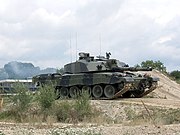Army
[edit] Statistics


The
Challenger 2, the British Army's
main battle tank.


A
Pinzagauer Vector, which along with the
Panther CLV is replacing the
Land Rover from front line service
British Army statistics[9]Personnel (Regular Army)109,000Personnel (
Territorial Army)34,000
Main Battle Tanks386
Challenger 2Light Tanks325
FV107 ScimitarInfantry fighting vehicles789
Warrior. 305
Tempest MPVAPCs and
CVR(T)s3,230–4,000+
Land Rover Wolf15,000
Pinzgauer2,000
Utility Trucks2,300
Artillery pieces and
mortar2,896Air Defence337
Aircraft300+
[edit] 'High Intensity' Operations
CountryDatesDeploymentDetails
Afghanistan2001–7,800 troops rising in 2009 to 8,030British troops have been based in Afghanistan since the
US-led invasion there in 2001. Currently, under
Operation Herrick, the Army maintains troops in Camp Souter,
Kabul and a brigade on 6-monthly rotation in the southern province of
Helmand mostly based on Camp Bastion and forward operating bases. In late 2008, the resident brigade is 3 Commando Brigade. This brigade has previously done tours in Afghanistan. In June 2008, British Defence Secretary Des Browne announced British troop numbers in Afghanistan to increase by 230 to new high of more than 8,000 by spring 2009.
[10]Iraq2003–4,000 troopsAs part of
Operation Telic (Gulf War 2), the British Army participated in the invasion of Iraq. Following the decision for continued security operations, the UK commands the Multi-National Division (South-East) with a headquarters unit, National Support Element and a combat brigade rotated every 6 months (in mid 2008, 7 Armoured Brigade), along with troops from Italy, Norway, Romania, Denmark, the Netherlands, Czech Republic, Portugal and Lithuania. A large number of
Territorial Army soldiers have been deployed for a variety of tasks, both as individuals serving and as formed units. Troop numbers are gradually decreasing and all troops will be withdrawn by July 2009.
Kosovo2008600 troopsAs part of the
EU's peacekeeping force in Kosovo called
EULEX, the UK sent a battle-group based on
2 Rifles, a light infantry battalion of about 600 soldiers, to help maintain public order. This battalion has since returned to the UK.
[11]
CountryDatesDeploymentDetails
Cyprus1960–Two resident infantry battalions,
Royal Engineers,
16 Flight Army Air Corps and Joint Service Signals Unit at
Ayios Nikolaos as a part of
British Forces CyprusThe UK retains two
Sovereign Base Areas in Cyprus after the island's independence. The bases serve as forward bases for deployments in the Middle East. British forces are also deployed separately with
UN peacekeeping forces on the island.Principal facilities are Alexander Barracks at Dhekelia and Salamanca Barracks at Episkopi.
Falkland Islands1982–An infantry company group and an Engineers SquadronPreviously a platoon-sized
Royal Marines Naval Party served as garrison. After 1982 the garrison was enlarged, and bolstered with an RAF base at RAF Mount Pleasant on East Falkland.
Gibraltar1704–One infantry battalion, Joint Provost and Security Unit as a part of
British Forces GibraltarBritish Army garrison is provided by an indigenous regiment, the
Royal Gibraltar Regiment, which has been on the Army regular establishment since the last British regiment left in 1991.Rest of the
Middle East19903,700 troopsSince the
Gulf War in 1991, the UK has had a considerable military presence in the Middle East. Besides Iraq, there are also an additional 3,500 troops in
Saudi Arabia and Camp Beuhring,
Kuwait, as well as regular training Exercises in
Oman.
Sierra Leone1999About 1000 troopsThe British Army were deployed to Sierra Leone, a former British colony on Operation Palliser in 1999 to aid the government in quelling violent uprisings by militiamen, under
United Nations resolutions. Troops (
Royal Marines ) remain in the region to provide military support and training to the Sierra Leone government.
CountryDatesDeploymentDetails
Belize1981–British Army Training and Support Unit Belize and
25 Flight Army Air CorpsBritish troops have been based in
Belize since the country gained independence from the UK in 1981. Until 1994 Belize's neighbour,
Guatemala claimed the territory, and British troops were based in Belize to provide a deterrent force
Brunei1962–One battalion from the
Royal Gurkha Rifles, British Garrison, Training Team Brunei (TTB) and
7 Flight Army Air CorpsA Gurkha battalion has been maintained in Brunei since the
Brunei Revolt in 1962 at the request of
Sultan Omar Ali Saifuddin III. The Training Team Brunei (TTB) is the Army's jungle warfare school, while the small number of garrison troops support the battalion. 7 Flight Army Air Corps provides helicopter support to both the Gurkha battalion and the TTB.
Canada1972–
British Army Training Unit Suffield and
29 (BATUS) Flight Army Air CorpsA training centre in the
Alberta prairie which is provided for the use of British Army and
Canadian Forces under agreement with the
government of Canada. British forces conduct regular, major armoured training exercises here every year, with helicopter support provided by 29 (BATUS) Flight
AAC.
Germany1945–1st (UK) Armoured Division as part of
British Forces Germany and
12 Flight Army Air CorpsBritish forces remained in Germany after the end of
World War II. Forces declined considerably after the end of the
Cold War, although the lack of accommodation in the UK means forces will continue to be based in Germany.
KenyaBritish Army Training Unit KenyaThe Army has a training centre in Kenya, under agreement with the Kenyan government. It provides training facilities for three infantry battalions per year